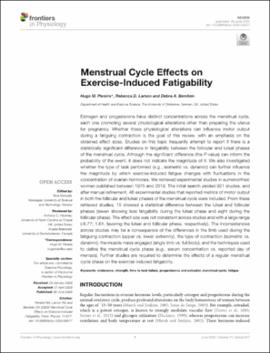| dc.contributor.author | Pereira, Hugo M. | |
| dc.contributor.author | Larsen, Rebecca D. | |
| dc.contributor.author | Bemben, Debra A. | |
| dc.date.accessioned | 2020-06-30T17:12:35Z | |
| dc.date.available | 2020-06-30T17:12:35Z | |
| dc.date.issued | 2020-06-26 | |
| dc.identifier.citation | Pereira H.M., Larson R.D. , and Bemben D.A. (2020). Menstrual Cycle Effects on Exercise-Induced Fatigability. Front. Physiol.11:517. doi: 10.3389/fphys.2020.00517 | en_US |
| dc.identifier.uri | https://hdl.handle.net/11244/324930 | |
| dc.description.abstract | Estrogen and progesterone have distinct concentrations across the menstrual cycle, each one promoting several physiological alterations other than preparing the uterus for pregnancy. Whether these physiological alterations can influence motor output during a fatiguing contraction is the goal of this review, with an emphasis on the obtained effect sizes. Studies on the topic frequently attempt to report if there is a statistical significant difference in fatigability between the follicular and luteal phases of the menstrual cycle. Although the significant difference (P value) can inform the probability of the event, it does not indicate the magnitude of it. We also investigated whether type of task performed (e.g., isometric vs. dynamic) can further influence the magnitude by which exercise-induced fatigue changes with fluctuations in the concentration of ovarian hormones. We retrieved experimental studies in eumenorrheic women published between 1975 and 2019. The initial search yielded 920 studies and after manual refinement, 46 experimental studies that reported metrics of motor output in both the follicular and luteal phases of the menstrual cycle were included. From these retrieved studies, 15 showed a statistical difference between the luteal and follicular phases (7 showing less fatigability during the luteal phase and 8 during the follicular phase). The effect size was not consistent across studies and with a large range (-6.77; 1.61, favoring the luteal and follicular phase respectively). The inconsistencies across studies may be a consequence of the differences in the limb used during the fatiguing contraction (upper vs. lower extremity), type of contraction (isometric vs. dynamic), the muscle mass engaged (single limb vs. full body), and the techniques used to define menstrual cycle phase (e.g. serum concentration vs. reported day of menses). Further studies are required to determine the effects of regular menstrual cycle phase on the exercise-induced fatigability. | en_US |
| dc.description.sponsorship | Financial support was provided from the Office of the Vice President for Research and Partnerships and the Office of the Provost, the University of Oklahoma – Norman Campus. Open Access fees paid for in whole or in part by the University of Oklahoma Libraries. | en_US |
| dc.language | en_US | en_US |
| dc.rights | Attribution 4.0 International | * |
| dc.rights.uri | https://creativecommons.org/licenses/by/4.0/ | * |
| dc.subject | Endurance | en_US |
| dc.subject | strength | en_US |
| dc.subject | time to task failure | en_US |
| dc.subject | Progesterone & estradiol | en_US |
| dc.subject | Menstrual Cycle | en_US |
| dc.subject | Fatigue | en_US |
| dc.title | Menstrual cycle effects on exercise-induced fatigability | en_US |
| dc.type | Article | en_US |
| dc.description.peerreview | Yes | en_US |
| dc.identifier.doi | 10.3389/fphys.2020.00517 | en_US |
| ou.group | College of Arts and Sciences::Department of Health and Exercise Science | en_US |

